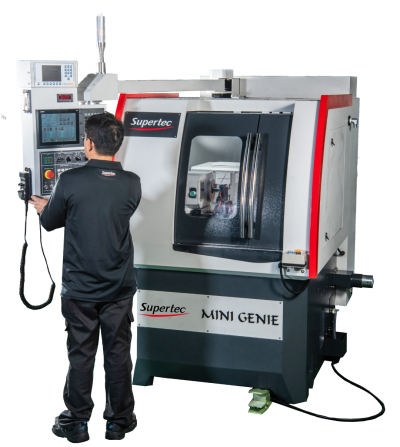
Supertec Machinery introduces the Mini Genie CNC cylindrical grinder to the North American market. The Mini Genie is designed for shops with limited floor space in mind. With a total footprint of only 78” x 78” (43 sq. ft.) and its high precision performance this grinder is ideal for any shop.
The Mini Genie has a grinding capacity of 9” diameter, and 8” between centers and a work load capacity of 44 lb. between centers and 11 lbs. chucked. With the Mitsubishi M80 control and Supertec’s I-Grind conversational shop floor language the grinder is easy to learn and easy to program making it ideal for any shop.
The Mini Gene comes in two styles, a plunge model with the wheelhead set at 90 degrees and the angle head model with the wheehead set at 20 degrees. The angle head is ideal for faster stock removal and a finer surface finish on face and shoulder grinding applications. A Heidenhain 0.000002” linear scale is used for improved accuracy and repeatability with machine tolerances of 0.0001” or better attainable. Both machine axes utilize linear guideways for a smoother more accurate movement.
Some of the standard features of the Mini Genie include a full enclosure, infinitely variable workhead, coolant system with paper filter and magnetic separator, and a taper adjustable tailstock.
Contact Details
Related Glossary Terms
- centers
centers
Cone-shaped pins that support a workpiece by one or two ends during machining. The centers fit into holes drilled in the workpiece ends. Centers that turn with the workpiece are called “live” centers; those that do not are called “dead” centers.
- computer numerical control ( CNC)
computer numerical control ( CNC)
Microprocessor-based controller dedicated to a machine tool that permits the creation or modification of parts. Programmed numerical control activates the machine’s servos and spindle drives and controls the various machining operations. See DNC, direct numerical control; NC, numerical control.
- coolant
coolant
Fluid that reduces temperature buildup at the tool/workpiece interface during machining. Normally takes the form of a liquid such as soluble or chemical mixtures (semisynthetic, synthetic) but can be pressurized air or other gas. Because of water’s ability to absorb great quantities of heat, it is widely used as a coolant and vehicle for various cutting compounds, with the water-to-compound ratio varying with the machining task. See cutting fluid; semisynthetic cutting fluid; soluble-oil cutting fluid; synthetic cutting fluid.
- grinding
grinding
Machining operation in which material is removed from the workpiece by a powered abrasive wheel, stone, belt, paste, sheet, compound, slurry, etc. Takes various forms: surface grinding (creates flat and/or squared surfaces); cylindrical grinding (for external cylindrical and tapered shapes, fillets, undercuts, etc.); centerless grinding; chamfering; thread and form grinding; tool and cutter grinding; offhand grinding; lapping and polishing (grinding with extremely fine grits to create ultrasmooth surfaces); honing; and disc grinding.






